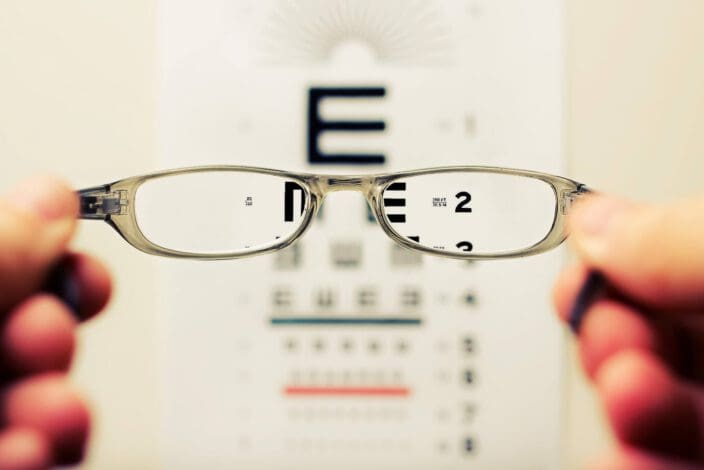California Driving Vision Requirements: Explained
Home / Vision Education Center / Vision & Vision Loss Impacts on Driving /
Last Updated:
While not technically the best vision possible, 20/20 vision is generally considered the baseline for “normal” vision. Since 20/20 vision would be too restrictive a requirement of drivers, drivers in California are required to have at least 20/40 vision in one eye, with at least 20/70 vision in their worse eye.
Table of Contents
If your corrected vision in your best eye is worse than 20/200 vision, you cannot drive in California. Several medical conditions can also cause you to be unable to drive unless you are approved by a specialist or via a special hearing. In some cases, people with vision problems may be permitted to drive, but they may be limited to only driving in the day.
Drivers who are age 70 or older will be required to retake some of the tests required to get their license, including a vision test, whenever they renew their license. You may be required to retake your test if a family member or relevant professionals are worried you are unsafe on the road.

California Vision Requirements
California is a big state with busy roads, so it shouldn’t be surprising that they have various laws that regulate driving. To help make roads safer, California’s Department of Motor Vehicles (DMV) requires that people seeking their driving license must pass a vision test, written exam, and practical driving test.
To understand California’s driving vision requirements, it’s important to grasp how visual acuity is measured. While better vision is possible, the gold standard for vision is generally considered 20/20 vision.
You deserve clear vision. We can help.
With 135+ locations and over 2.5 million procedures performed, our board-certified eye surgeons deliver results you can trust.
Your journey to better vision starts here.
At this level of visual acuity, a person at 20 feet can see at the same level of detail as what a person with essentially perfect vision can see at 20 feet. While this level of vision is more or less ideal, it is relatively rare. As a result, it is too strict a cutoff when determining who can safely drive.
Generally, 20/40 vision is considered a good cutoff for visual acuity. Below that is when vision can really start to affect one’s driving ability, although not necessarily enough that you shouldn’t be able to drive at all (discussed later). If you have 20/40 vision, it means that you can details at 20 feet that someone with “normal” vision could see at a distance of 40 feet.
To drive unrestricted, you must either have 20/40 vision in both eyes, or 20/40 vision in one eye and 20/70 vision (or better) in your other eye. If you can reach this level of visual acuity with glasses or other corrective wear, you can generally drive unrestricted so long as you only drive while wearing that corrective wear.
If you benefit from glasses but can pass this standard test without them, you may wish to do so. This is because it will allow you to legally drive without your glasses. You can then, of course, always drive with them if you want, but it’s not a legal requirement for you to wear them while driving.
Driving With Worse Vision & Hard Limits
If corrective wear (if needed) cannot allow you to reach a level of visual acuity better than 20/200 vision (where at 20 feet you see a level of detail a person with normal vision can see at 200 feet) in at least one eye, you cannot drive in California. While normal corrective wear is allowed when testing this limit, special wear (such as bioptic telescopic lenses and similar lenses) are not.
You also cannot drive with monovision in California unless a vision specialist fills out a form saying it is okay, and you then pass a driving test to confirm you are capable of driving safely.
Some other health conditions may require that you go to a special hearing to see if you’re capable of safely driving. Many of these conditions affect vision. They include:
- Head trauma.
- Kaposi’s sarcoma ocular lesions.
- Multiple sclerosis.
- Brain tumor or lesion.
- Cerebral palsy.
- Diabetic retinopathy.
Assuming you have not otherwise been barred from driving due to other requirements, the use of a bioptic telescopic lens is permitted for the driving portion of your test (not the vision test).
If you pass the test in the daytime but need bioptic telescopic lenses, you will be restricted to driving during the day, and you’ll be required to wear them while driving. If you are able to pass the test at night, your only restriction will be you need to wear the lenses while driving.

You deserve clear vision. We can help.
With 135+ locations and over 2.5 million procedures performed, our board-certified eye surgeons deliver results you can trust.
Your journey to better vision starts here.
How Often Must I Retake the Vision Test?
Assuming they pass, most people will only have to take the vision test for driving once, until they are over 70 years old and need to renew their license. Certain driving-related laws apply to senior individuals in California.
Once you hit age 70, California requires that you start renewing your license in person every five years. When you renew in person, you’ll have to take both a vision test and a written test. If there are concerns about your driving, you may also be required to take a driving test.

The reasoning behind this testing is to make sure seniors can drive safely. Driving ability often regresses as people age. There is almost always a moderate decline in vision associated with aging, so it is important to test drivers who may not be aware of this decline since it happens so gradually.
Most often, people take the vision test for free at the DMV. A licensed optometrist or ophthalmologist can also perform the exam. They will then need to complete a Report of Vision Examination. This exam must be done within six months of the driver’s license renewal.
Other Requirements for Senior Drivers in California
As with most states, drivers can also be reported as a potential risk on the road. If you have a health condition, including a vision condition, that a relevant professional or family member thinks might affect your driving, they can report this to the California DMV. Depending on the condition and the report, the DMV may decide that a reexamination is in order.
A reexamination is similar but not identical to how you first got your license. You will be asked several questions to make sure you know how to drive safely. You may be required to take a vision test, written test, and potentially your practical driving test again.
California law also specifies that doctors must report certain health conditions to the DMV. If a patient is diagnosed with Alzheimer’s disease or other health conditions that affect driving abilities, the doctor must report the diagnosis.
You should never drive if you think it would not be safe for you to do so, even if you are legally able to. Driving when you know it would be dangerous is irresponsible and could seriously hurt you or someone else.
You deserve clear vision. We can help.
With 135+ locations and over 2.5 million procedures performed, our board-certified eye surgeons deliver results you can trust.
Your journey to better vision starts here.
References
- Vision Standards (FFDL 14). California Department of Motor Vehicles (DMV).
- Vision Tests. California Department of Motor Vehicles (DMV).
- What Is the Minimum Vision Required for Driving in California? Shouse California.
- DMV Reexaminations. California Department of Motor Vehicles (DMV).
- California Driving Laws for Seniors and Older Drivers. NOLO.
- Driver License Renewal Frequently Asked Questions. California Department of Motor Vehicles (DMV).
- Visual Acuity: What is 20/20 Vision? American Optometric Association (AOA).
- Vision Requirements for Driving Safety. (February 2006). International Council of Ophthalmology.
This content is for informational purposes only. It may have been reviewed by a licensed physician, but is not intended to serve as a substitute for professional medical advice. Always consult your healthcare provider with any health concerns. For more, read our Privacy Policy and Editorial Policy.
